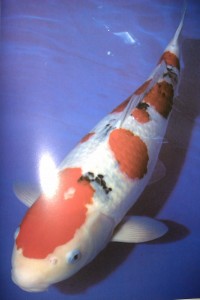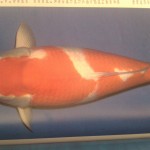Taisho Sanke
Sanke, are another popular koi, along with Kohaku and Showa. Sanke means tri-color, the three colors being red, white and black. In Japanese characters the word Sanke is also read as Sanshoku, the term used in early works on koi.” (Kin Matsuba pg.136) Hobbysts in many countries love the Sanke because of their extensive variety of designs.
Taisho is in reference to the period when the Sanke was first recorded in Japanese history. This was between 1912 and 1926. “Over the past 60 years the markings of the Sanke have changed quite dramatically. The first Sanke were very striped in appearance , but todays show winning Sanke is a beautifully balanced koi whose sumi, although deeper in shade, is more delicate in appearance than that of its ancestors.” (Kin Matsuba pg.136)
Matsuba, Kin-“The Tetra Encyclopedia of Koi” By, Kin Matsuba

